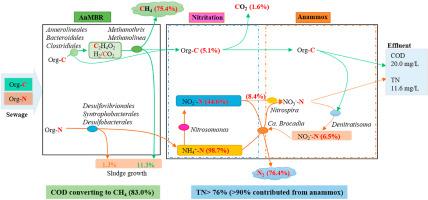Journal of Cleaner Production ( IF 9.7 ) Pub Date : 2020-09-18 , DOI: 10.1016/j.jclepro.2020.124245 Zhen Lei , Shuming Yang , Lianxu Wang , Xingyuan Huang , Xiaochang C. Wang , Yu-You Li , Qian Li , Yu Zhao , Rong Chen

|
A novel sewage treatment process aimed at achieving successive methanation and low-carbon denitrogenation was configured by integrating anaerobic membrane bioreactors with nitritation-Anammox. The system performance, pollutant removal pathways, and process dynamics were investigated via analysis of pollutant transformations and microbial consortia in each reactor. The results indicated average removal efficiencies of 97.3 % and 76.4 %, respectively, for chemical oxygen demand and total nitrogen, corresponding to a chemical oxygen demand-to-methane conversion rate of over 83 %. Organics removal was achieved mainly in the anaerobic membrane bioreactor, while denitrogenation was attained in the Anammox reactor. Hydrolysis and acidification in the anaerobic membrane bioreactor was attributable mainly to Anaerolineales, Bacteroidales, and Clostridiales. Methanothrix (58.4 %) and Methanolinea (30.0 %) were the primary contributors to methane production. Almost half of the NH4+-N in the AnMBR effluent was converted into NO2--N in the nitritation reactor by Nitrosomonas. Ca. Brocadia contributed to further oxidation and removal of the residual NH4+-N using NO2--N in the Anammox reactor. Overall, upfront methanation and subsequent low-carbon denitrogenation were achieved by integrating anaerobic membrane bioreactors with nitritation-Anammox, which provides a promising technology in the new paradigm of wastewater treatment.
中文翻译:

通过新颖的三阶段工艺实现连续甲烷化和低碳脱氮,以进行高效节能的废水处理
通过将厌氧膜生物反应器与硝化厌氧氨氧化反应相集成,配置了旨在实现连续甲烷化和低碳脱氮的新型污水处理工艺。通过分析每个反应器中的污染物转化和微生物群落,研究了系统性能,污染物去除途径和过程动力学。结果表明,化学需氧量和总氮的平均去除效率分别为97.3%和76.4%,相当于化学需氧量向甲烷的转化率超过83%。有机物的去除主要在厌氧膜生物反应器中完成,而脱氧在Anammox反应器中实现。厌氧膜生物反应器中的水解和酸化主要归因于厌氧厌氧菌,拟杆菌和梭菌。甲烷甲烷(58.4%)和甲醇(30.0%)是甲烷生产的主要贡献者。亚硝化菌在亚硝化反应器中将AnMBR废水中几乎一半的NH 4 + -N转化为NO 2 -- N 。钙 Brocadia在Anammox反应器中使用NO 2 -- N进一步促进了氧化并去除了残留的NH 4 + -N 。总体而言,通过将厌氧膜生物反应器与硝化厌氧氨氧化反应相集成,可以实现前期甲烷化和随后的低碳脱氮,这为废水处理的新范式提供了有希望的技术。











































 京公网安备 11010802027423号
京公网安备 11010802027423号